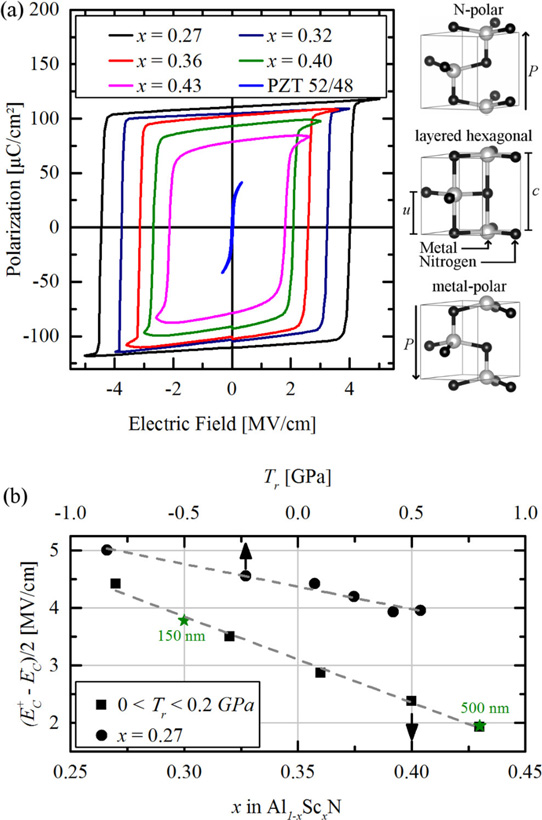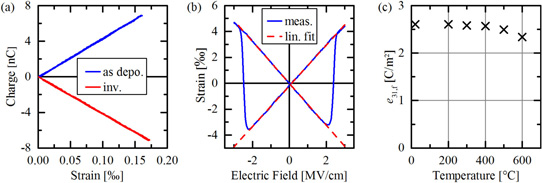- News
18 April 2019
Aluminium scandium nitride exhibits ferroelectric behavior
University of Kiel and Fraunhofer Institute for Silicon Technology (ISIT) in Germany claim the first demonstration of ferroelectric behavior in a III-V-based semiconductor [Simon Fichtner et al, J. Appl. Phys., vol125, p114103, 2019].
The researchers used aluminium scandium nitride (AlScN) alloy in their demonstration, but they also believe other group III (group 13 in more modern periodic table notation) elements such as gallium (e.g. GaScN) and group-3 scandium-relative yttrium (e.g. AlYN) could provide materials with ferroelectric behavior. Moving from group 3, the quaternary alloy aluminium magnesium niobium nitride (AlMgNbN) is another contender, they report. Magnesium is group 2 and niobium group 5.
The team comments: “Ferroelectric switching allowed the first direct experimental observation of the switching of spontaneous polarization in an AlN-based material and confirmed that, contrary to most prior theoretical publications, it can reach values larger than 100μC/cm2.”
Ferroelectric materials have a charge polarization that can be switched in direction by an applied electric field. Oxide perovskites, such as lead zirconate titanate (PZT), are commonly studied and used as ferroelectrics, but they suffer from low paraelectric transition temperatures, non-linear displacements, or limited compatibility with silicon CMOS or III-nitride manufacturing.
Classical ferroelectric applications include piezoelectric multi-layer actuator stacks and non-volatile memory cells. However, the team also sees potential for optoelectronics, multi-ferroic (electrical, magnetic, elastic) composites, and III-nitride electronics.
AlN has the wurtzite crystal structure, in common with other III-nitride semiconductors such as GaN. The charge polarization of the unit cell is fixed by the relative positions of the component group-III and nitrogen atoms. AlN has strong spontaneous polarization and piezoelectric effects.
Introducing scandium increases the piezoelectric effect while the wurtzite structure is maintained. The researchers explain: “This can be related to a highly metastable layered-hexagonal phase (space group P63/mmc) in ScN, which in turn flattens the ionic potential energy landscape of, e.g., wurtzite-type Al1-xScxN.”
The non-polar layered-hexagonal structure offers a transitional form between two polarization orientations of the wurtzite structure. The researchers see lowering the energy barrier between the two polarization states of the wurtzite structure as key to ferroelectric switching in AlScN.
Polycrystalline AlScN films were formed by sputtering onto an AlN on platinum on silicon electrode. All the samples were produced by using dual targets, except Al0.64Sc0.36N, which used a single AlSc alloy target with 43% Sc content. The nitrogen was supplied as a gas at 15 standard cubic centimeters per minute, along with 7.5sccm argon. The substrate temperature was 400°C. A top electrode of platinum completed the test structures.
The material showed ferroelectric hysteresis loops (Figure 1). When the scandium content was less than 22%, the material suffered dielectric breakdown before the coercive field value was reached. The coercive field for polarization reduced from ~5MV/cm in Al0.73Sc0.27N to less than 2MV/cm in Al0.57Sc0.43N. Changes in mechanical stress could enable tuning of the coercive field of the order of 1MV/cm for Al0.73Sc0.27N films, according to measurements between -0.8GPa and +0.5GPa.

Figure 1: (a) Charge polarization-electric field (P-E) loops of ferroelectric Al1-xScxN as well as of PZT reference. To right, structures associated with respective polarization states. (b) Dependence of mean coercive field on residual stress (Tr) and Sc content.
The piezoelectric effect was measured both as-deposited and after ferroelectric inversion (Figure 2). For Al0.64Sc0.36N films the effective transverse piezoelectric coefficient charge/strain gradient was -2.90C/m2 as-deposited and +2.76C/m2 inverted. The researchers comment: “Both values can be considered high for an AlN-based solid solution. Repeated measurements of the piezoelectric response up to 30 weeks after polarization inversion did not show measurable degradation.”

Figure 2: (a) Direct piezoelectric effect: Charge-strain curves of Al0.64Sc0.36N as-deposited and after ferroelectric polarization inversion. (b) Converse piezoelectric effect: longitudinal strain response. (c) Transverse piezoelectric coefficient after polarization inversion and successive temperature treatments without subsequent repolarization.
The polarization inversion was found to be stable after temperature treatments up to 600°C, placing the paraelectric transition above that value. The test structure electrodes degraded above 600°C.
The inverse piezoelectric response under electrical bias exhibited two linear regimes, giving effective longitudinal piezoelectric coefficients of +15.7pm/V and -16.2pm/V. “Compared to state-of-the-art polycrystalline ferroelectric thin-films, both the width of the linear strain regime of 0.7% and its symmetry around the field axis are outstanding,” the team writes.
The researchers used wet etching experiments to confirm that the ferroelectric-like effects were due to changes on the unit-cell level of the crystal structure, rather some more macroscopic effect of charge transfer due to the presence of p-n/Schottky junctions or electrets (charge polarization equivalent of magnets). In the experiments the inverted material was etched mainly around defects and non-switched domains. By contrast, as-deposited material etched readily with a characteristic cone-like surface morphology.
Further experiments showed expected electrical polarization retention and performance under frequency-dependent measurements. Electron microscopy and diffraction were also used in these efforts.
https://doi.org/10.1063/1.5084945
The author Mike Cooke is a freelance technology journalist who has worked in the semiconductor and advanced technology sectors since 1997.


